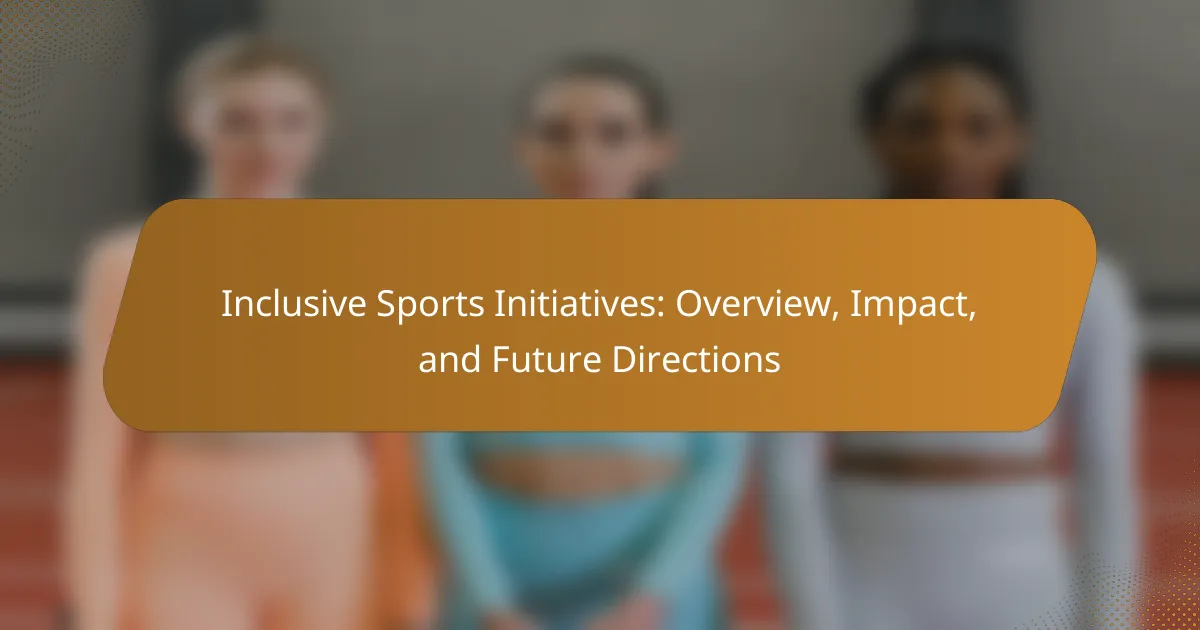Inclusive sports initiatives enhance participation for individuals of all abilities and backgrounds. They focus on accessibility, community engagement, and equitable opportunities. Leading organizations like the International Paralympic Committee and Special Olympics drive these efforts, creating impactful programs worldwide. Challenges such as funding and societal attitudes persist, but future directions emphasize expanding access and promoting awareness through innovative solutions.
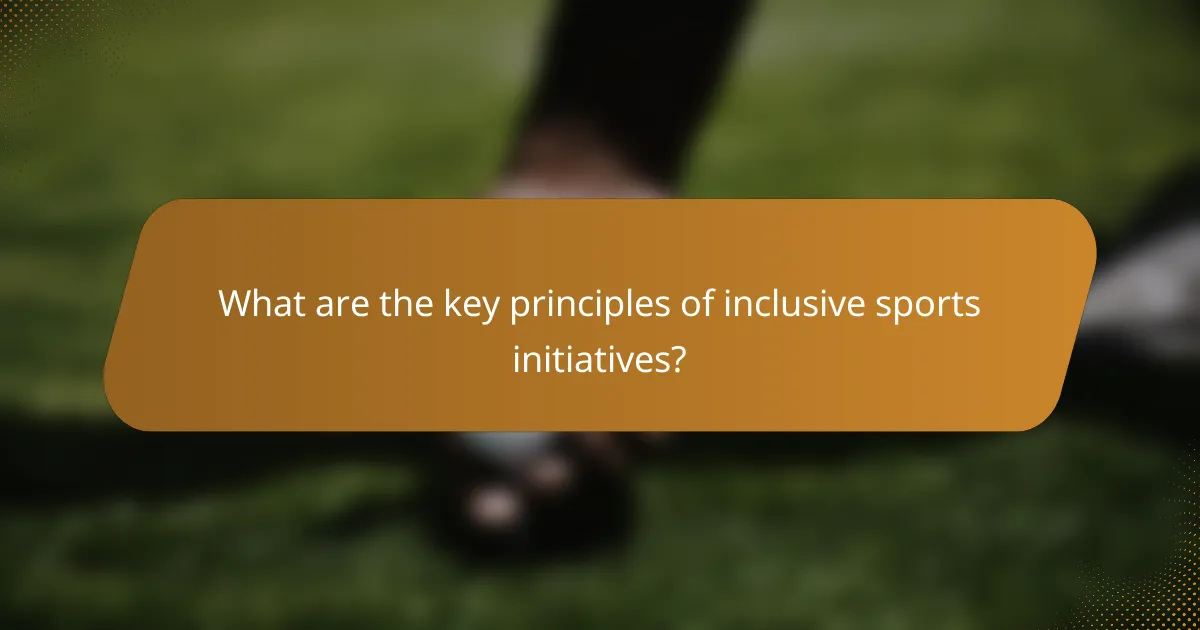
What are the key principles of inclusive sports initiatives?
Inclusive sports initiatives promote participation for all individuals, regardless of ability or background. Key principles include accessibility, community engagement, and equitable opportunities. Accessibility ensures facilities and programs accommodate diverse needs. Community engagement fosters relationships and support among participants. Equitable opportunities guarantee all individuals can participate without barriers. These principles enhance social inclusion, promote physical health, and build community cohesion.
How do inclusive sports initiatives promote accessibility?
Inclusive sports initiatives enhance accessibility by creating environments that accommodate diverse abilities. These programs often include adaptive equipment, trained staff, and tailored activities. As a result, individuals with disabilities can participate fully, fostering social inclusion and physical health. Research shows that inclusive sports improve self-esteem and community engagement among participants. Future directions focus on expanding outreach and integrating technology to further enhance accessibility.
Why is community engagement essential for success?
Community engagement is essential for success in inclusive sports initiatives as it fosters collaboration and enhances participation. Engaging diverse community members leads to greater awareness and support for programs, ultimately increasing their impact. When stakeholders are involved, initiatives become more responsive to local needs, ensuring sustainability and relevance. Furthermore, community engagement cultivates a sense of belonging, motivating individuals to participate and contribute, which strengthens the overall effectiveness of sports initiatives.
What role does policy play in shaping inclusive sports?
Policy plays a crucial role in shaping inclusive sports by establishing frameworks that promote accessibility and participation. Effective policies ensure equitable opportunities for individuals with diverse abilities, fostering an environment where everyone can engage in sports activities. These initiatives often include funding for adaptive equipment, training programs, and community outreach efforts. As a result, inclusive sports policies not only enhance participation rates but also contribute to social integration and community cohesion. The future of inclusive sports relies on continuous policy development that adapts to the evolving needs of diverse populations.

Which organizations are leading inclusive sports initiatives globally?
Organizations leading inclusive sports initiatives globally include the International Paralympic Committee, Special Olympics, and the Women’s Sports Foundation. These entities focus on promoting participation in sports for individuals with disabilities and underrepresented groups. Their initiatives create opportunities, raise awareness, and foster community engagement. For instance, the Special Olympics offers year-round training and competitions for people with intellectual disabilities, impacting millions worldwide. The future of inclusive sports relies on expanding these efforts and increasing accessibility.
What innovative programs are being implemented by local sports clubs?
Local sports clubs are implementing innovative inclusive sports initiatives to promote diversity and accessibility. These programs focus on adaptive equipment, specialized training, and community engagement. For example, clubs are organizing mixed-ability events that encourage participation from various skill levels and backgrounds. As a result, these initiatives enhance social interaction and foster a sense of belonging among participants. Future directions include expanding partnerships with schools and local organizations to further support inclusive practices in sports.
How do national governing bodies support inclusivity in sports?
National governing bodies support inclusivity in sports by implementing policies, programs, and partnerships that promote equal access and participation. They create initiatives that target underrepresented groups, ensuring diverse representation in all levels of sport. For example, many organizations offer funding for adaptive equipment and training for athletes with disabilities. These efforts not only enhance participation but also foster a culture of acceptance and respect. As a result, the impact of inclusivity initiatives can lead to increased overall engagement in sports and improved community cohesion.
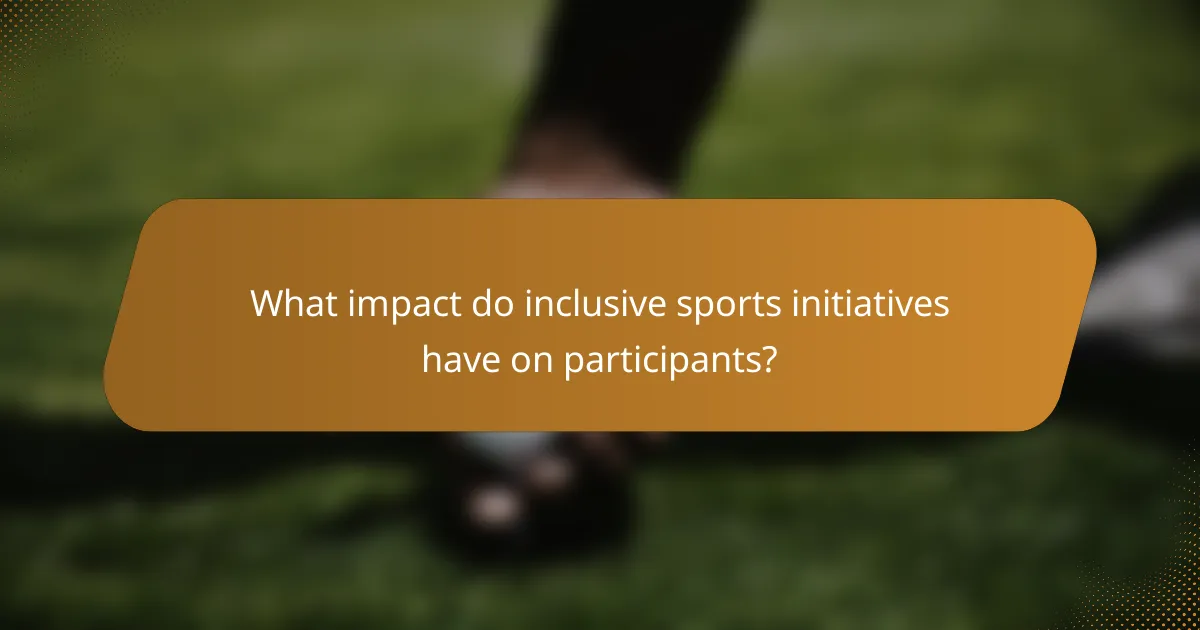
What impact do inclusive sports initiatives have on participants?
Inclusive sports initiatives significantly enhance participants’ physical and mental well-being. These programs foster social connections, improve self-esteem, and promote teamwork. Participants often report increased motivation and a sense of belonging. Research indicates that inclusive sports can lead to improved physical health metrics, such as increased activity levels and reduced obesity rates. Additionally, these initiatives contribute to breaking down societal barriers and stereotypes, promoting greater acceptance and understanding among diverse groups.
How do these initiatives enhance social cohesion?
Inclusive sports initiatives enhance social cohesion by fostering connections among diverse community members. They promote teamwork, mutual respect, and understanding through shared experiences. Participation in these initiatives reduces social barriers, encouraging inclusion and collaboration. As a result, communities become more resilient and unified, leading to improved social interactions and support networks.
What are the psychological benefits for participants?
Participants in inclusive sports initiatives experience enhanced self-esteem, improved mental health, and stronger social connections. These psychological benefits stem from increased feelings of belonging and acceptance within diverse communities. Engaging in sports fosters resilience and coping skills, contributing to overall well-being. As a result, participants often report reduced anxiety and depression levels, highlighting the transformative impact of inclusive sports.
Which demographic groups benefit most from these initiatives?
Children, individuals with disabilities, and marginalized communities benefit most from inclusive sports initiatives. These groups gain access to physical activity, social integration, and improved mental health. For example, children develop teamwork skills, while individuals with disabilities experience enhanced self-esteem. Marginalized communities often see increased opportunities for engagement and representation in sports. As a result, these initiatives foster a more equitable sporting environment.
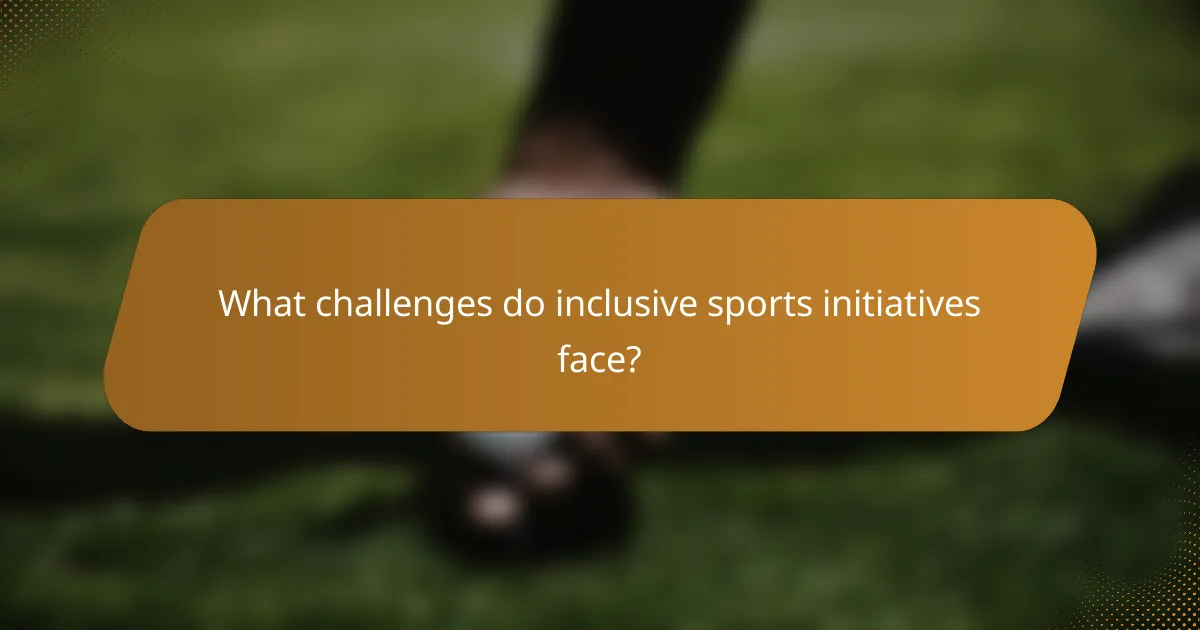
What challenges do inclusive sports initiatives face?
Inclusive sports initiatives face challenges such as funding limitations, accessibility issues, and societal attitudes. These barriers hinder participation and growth in diverse communities.
Funding constraints often limit the resources available for programs, affecting outreach and sustainability. Accessibility issues include inadequate facilities and transportation, which can prevent individuals with disabilities from participating. Societal attitudes, including stigma and lack of awareness, can discourage involvement and support for inclusive sports.
Addressing these challenges requires targeted strategies, collaboration with stakeholders, and increased advocacy to promote inclusivity in sports.
How can funding limitations hinder progress?
Funding limitations significantly hinder progress in inclusive sports initiatives by restricting resources for programs, facilities, and outreach efforts. Insufficient funding leads to fewer opportunities for participation and limits the development of adaptive sports equipment. Consequently, this affects the overall impact of these initiatives on community engagement and athlete performance. As a result, the future of inclusive sports may be compromised without increased financial support.
What are the common misconceptions about inclusive sports?
Common misconceptions about inclusive sports include the belief that they are only for individuals with disabilities, that they lack competitiveness, and that they do not require specialized training. These misconceptions can hinder participation and support for inclusive initiatives. Inclusive sports actually encompass a diverse range of participants and emphasize the importance of teamwork and skill development. Additionally, they promote social integration and community engagement, challenging the notion that inclusivity diminishes athletic performance.
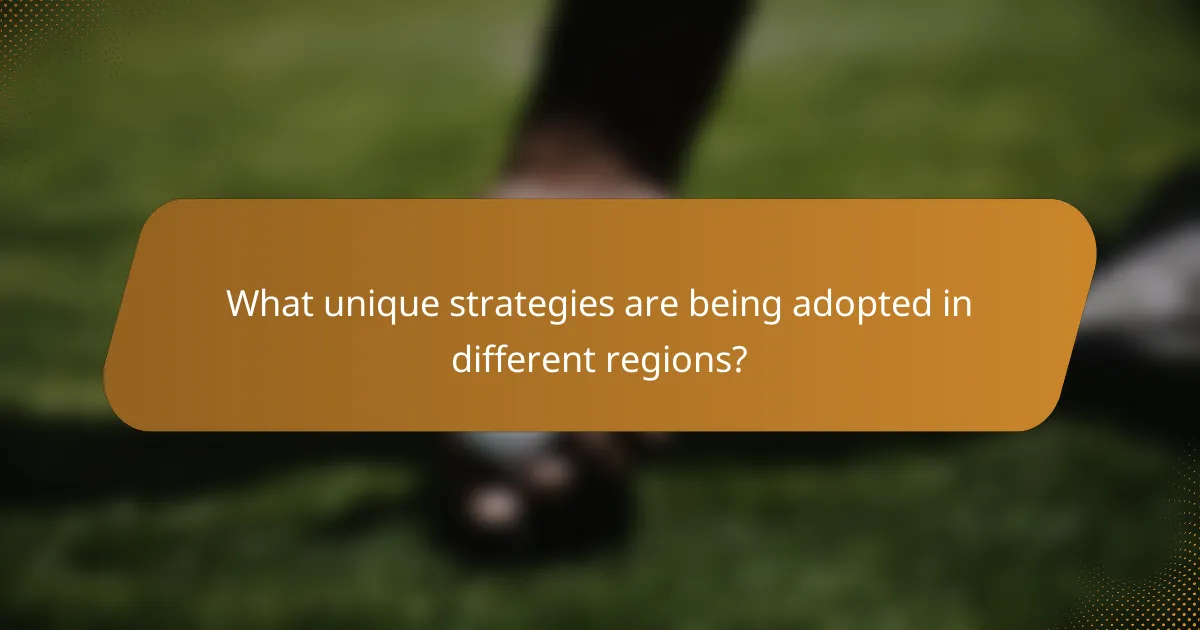
What unique strategies are being adopted in different regions?
Different regions adopt unique strategies for inclusive sports initiatives, focusing on accessibility, community engagement, and tailored programs. For instance, Scandinavia emphasizes adaptive sports through government funding, while Australia promotes grassroots involvement with local clubs. In the U.S., schools integrate inclusive physical education to foster participation. Meanwhile, countries like Japan incorporate technology to enhance accessibility for athletes with disabilities. These approaches reflect cultural values and resource availability, shaping the future of inclusive sports globally.
How is technology shaping the future of inclusive sports?
Technology is significantly enhancing inclusive sports by improving accessibility and participation. Innovations like adaptive equipment and virtual platforms enable athletes with disabilities to compete effectively. Wearable technology provides real-time performance data, fostering personalized training. Additionally, social media campaigns raise awareness and promote inclusivity, encouraging broader community engagement. As a result, technology is not only transforming how inclusive sports are played but also expanding opportunities for diverse athletes.
What role do grassroots movements play in promoting inclusivity?
Grassroots movements play a crucial role in promoting inclusivity in sports by fostering community engagement and advocacy. These initiatives empower marginalized groups, ensuring equal access and opportunities in sports. They often focus on local needs, creating tailored programs that enhance participation. For example, grassroots organizations can address barriers such as socioeconomic status or physical disabilities, making sports more accessible. As a result, these movements not only increase participation rates but also cultivate a culture of inclusivity and acceptance within the broader sports community.

What are the future directions for inclusive sports initiatives?
Future directions for inclusive sports initiatives focus on expanding accessibility, enhancing representation, and fostering community engagement. These initiatives aim to create environments where all individuals, regardless of ability or background, can participate in sports.
Innovative technology will play a crucial role in improving accessibility, such as adaptive equipment and virtual platforms. Increased funding and partnerships with organizations dedicated to inclusivity will further support these efforts.
Moreover, promoting awareness through educational programs will help dismantle stereotypes and encourage participation from diverse populations. As a result, inclusive sports initiatives will continue to evolve, creating lasting social impact.
How can partnerships enhance the effectiveness of these initiatives?
Partnerships enhance the effectiveness of inclusive sports initiatives by leveraging resources, expertise, and networks. Collaborative efforts increase outreach and engagement, ensuring diverse participation. For example, local organizations can provide insights into community needs, while corporate sponsors can offer funding and visibility. These synergies foster sustainable programs, amplifying impact and promoting long-term growth.
What trends are emerging in inclusive sports for 2025?
Emerging trends in inclusive sports for 2025 focus on enhanced accessibility, technology integration, and community engagement. Organizations are prioritizing adaptive equipment and facilities, ensuring participation for individuals with diverse abilities.
The use of virtual reality and augmented reality is increasing, providing immersive training experiences and simulations that cater to various needs. Additionally, grassroots movements are gaining momentum, fostering local inclusive sports programs that promote social inclusion and awareness.
Partnerships with technology companies are becoming common, aimed at developing innovative solutions for tracking performance and improving athlete experience. Finally, increased funding and sponsorships are expected to drive more inclusive initiatives, expanding opportunities for underrepresented groups in sports.
What best practices can organizations adopt to improve inclusivity?
Organizations can adopt several best practices to improve inclusivity in sports initiatives. First, they should ensure diverse representation in leadership roles and decision-making processes. Second, providing accessible facilities and resources for individuals of all abilities is crucial. Third, implementing training programs that focus on cultural competency can enhance understanding and respect among participants. Finally, fostering partnerships with community organizations can expand outreach and engagement efforts. These practices contribute to a more inclusive environment that benefits all participants.
